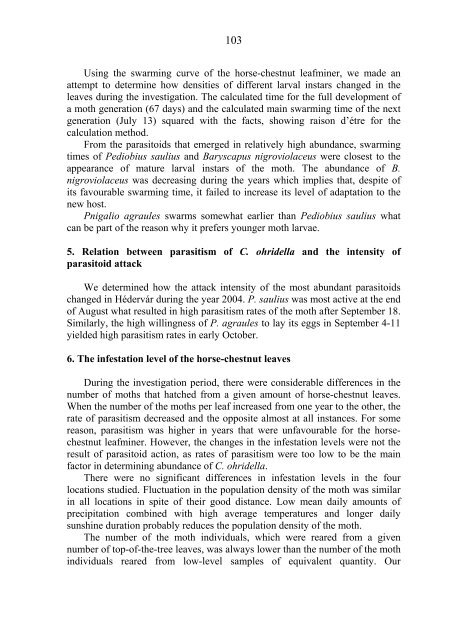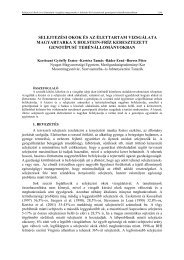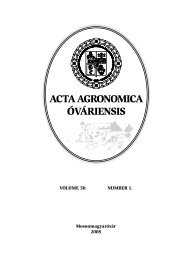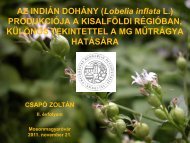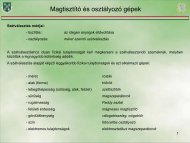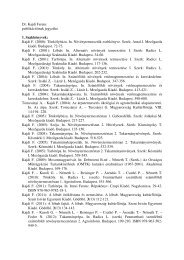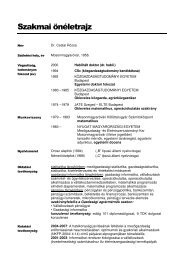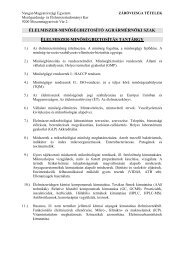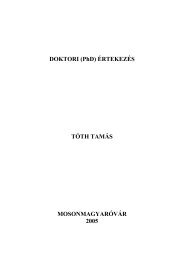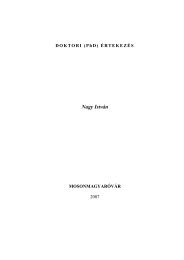DOKTORI (PhD) - Nyugat-Magyarországi Egyetem Mezőgazdaság
DOKTORI (PhD) - Nyugat-Magyarországi Egyetem Mezőgazdaság
DOKTORI (PhD) - Nyugat-Magyarországi Egyetem Mezőgazdaság
You also want an ePaper? Increase the reach of your titles
YUMPU automatically turns print PDFs into web optimized ePapers that Google loves.
103<br />
Using the swarming curve of the horse-chestnut leafminer, we made an<br />
attempt to determine how densities of different larval instars changed in the<br />
leaves during the investigation. The calculated time for the full development of<br />
a moth generation (67 days) and the calculated main swarming time of the next<br />
generation (July 13) squared with the facts, showing raison d’étre for the<br />
calculation method.<br />
From the parasitoids that emerged in relatively high abundance, swarming<br />
times of Pediobius saulius and Baryscapus nigroviolaceus were closest to the<br />
appearance of mature larval instars of the moth. The abundance of B.<br />
nigroviolaceus was decreasing during the years which implies that, despite of<br />
its favourable swarming time, it failed to increase its level of adaptation to the<br />
new host.<br />
Pnigalio agraules swarms somewhat earlier than Pediobius saulius what<br />
can be part of the reason why it prefers younger moth larvae.<br />
5. Relation between parasitism of C. ohridella and the intensity of<br />
parasitoid attack<br />
We determined how the attack intensity of the most abundant parasitoids<br />
changed in Hédervár during the year 2004. P. saulius was most active at the end<br />
of August what resulted in high parasitism rates of the moth after September 18.<br />
Similarly, the high willingness of P. agraules to lay its eggs in September 4-11<br />
yielded high parasitism rates in early October.<br />
6. The infestation level of the horse-chestnut leaves<br />
During the investigation period, there were considerable differences in the<br />
number of moths that hatched from a given amount of horse-chestnut leaves.<br />
When the number of the moths per leaf increased from one year to the other, the<br />
rate of parasitism decreased and the opposite almost at all instances. For some<br />
reason, parasitism was higher in years that were unfavourable for the horsechestnut<br />
leafminer. However, the changes in the infestation levels were not the<br />
result of parasitoid action, as rates of parasitism were too low to be the main<br />
factor in determining abundance of C. ohridella.<br />
There were no significant differences in infestation levels in the four<br />
locations studied. Fluctuation in the population density of the moth was similar<br />
in all locations in spite of their good distance. Low mean daily amounts of<br />
precipitation combined with high average temperatures and longer daily<br />
sunshine duration probably reduces the population density of the moth.<br />
The number of the moth individuals, which were reared from a given<br />
number of top-of-the-tree leaves, was always lower than the number of the moth<br />
individuals reared from low-level samples of equivalent quantity. Our


